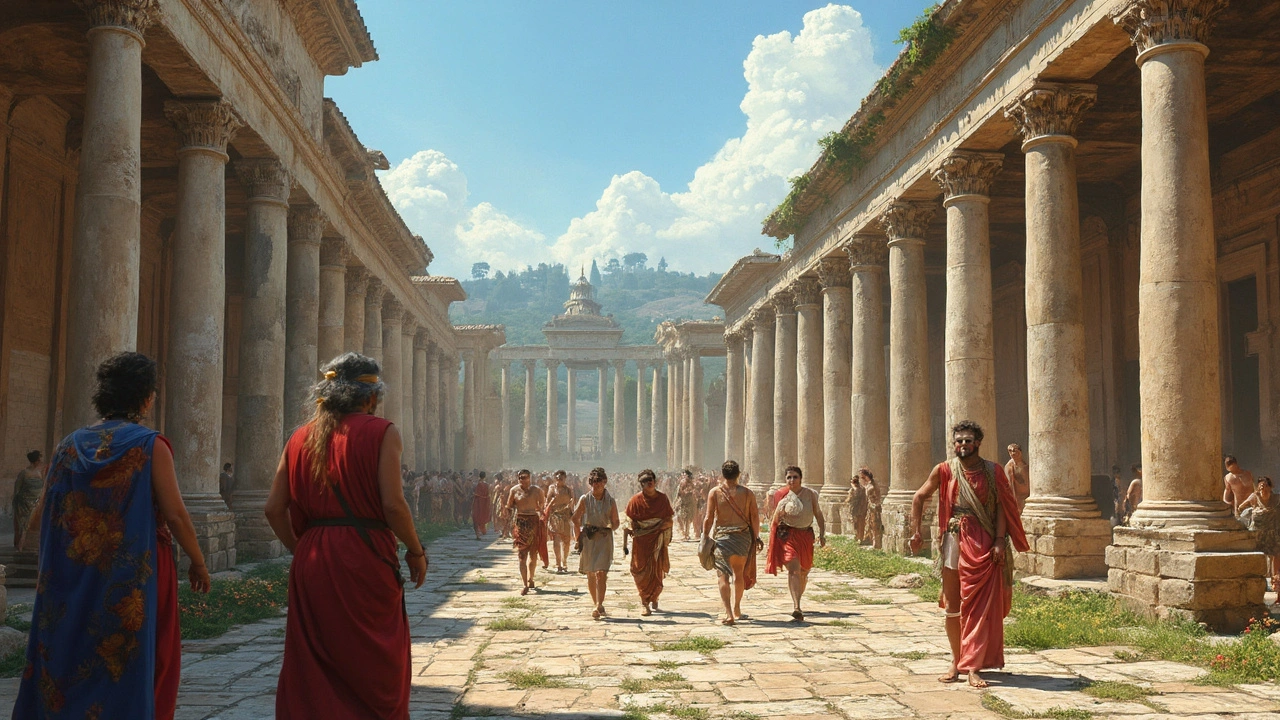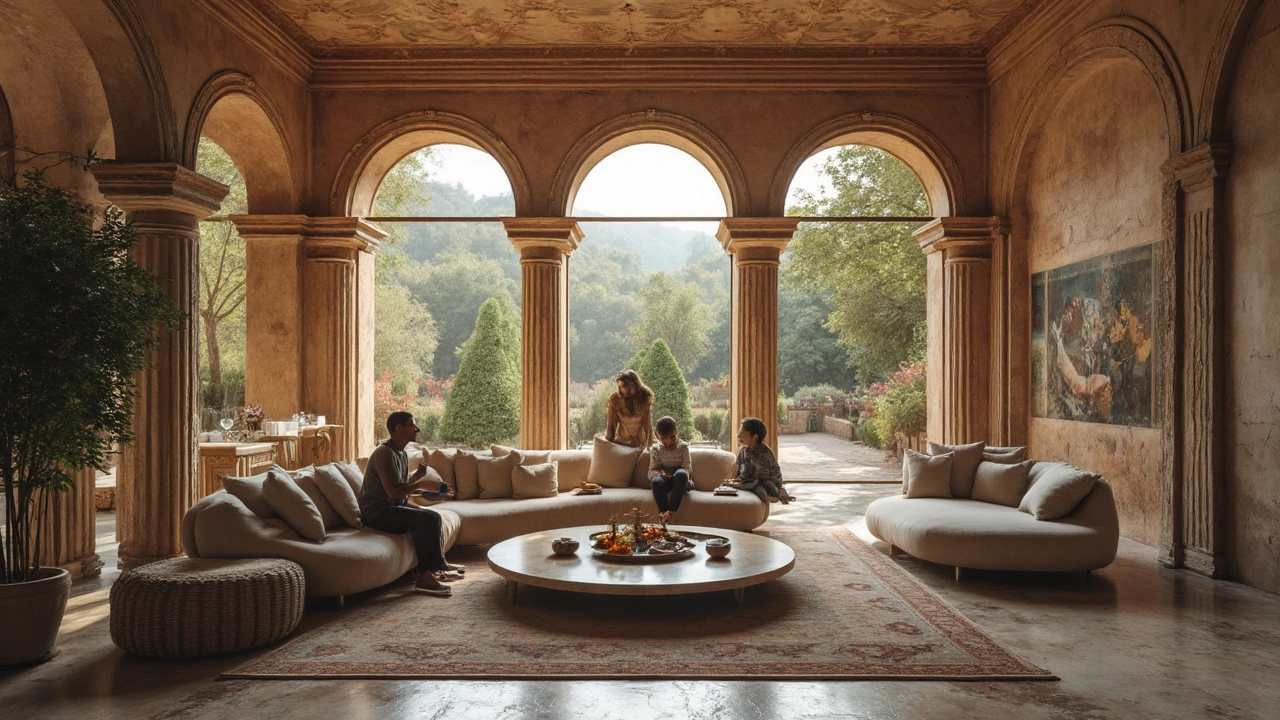Ancient Roman Architecture: Masterpieces, Engineering, and Lasting Influence
 Aug, 11 2025
Aug, 11 2025
Ancient Roman architecture isn’t just about old ruins and fancy columns—it’s a wild story of ambition, power, and game-changing design tricks that still wow us centuries later. The Romans loved to build things on a grand scale, and they didn’t just want their buildings to last—they wanted to impress, intimidate, and sometimes even show off a bit. The thing is, you don’t need to be a professor or an architect to appreciate why these structures matter. Whether you’re gazing up at the Colosseum, walking along a forgotten aqueduct, or chilling in an ancient bath, you can feel something deeply human in the stones, arches, and wide-open spaces. So, what’s behind all that enduring drama? Let’s take a close-up look.
Foundations: Where Roman Architecture Really Begins
Nothing about Roman building was an accident. They had big dreams, but they also based their designs on what came before—pulling inspiration from the Etruscans, Greeks, and even their Egyptian rivals. The Romans took basic stonework and columns and just went bigger, beefier, and bolder. Instead of just copying, they experimented like mad scientists. Their secret weapon? Concrete. Real Roman concrete (called opus caementicium) was made by mixing volcanic ash with lime and bits of stone, making it tougher and longer-lasting than anything else at the time.
Before you imagine gray blobs everywhere, think again. Roman builders used concrete to create sweeping domes, thick vaults, and curved walls. Once they had the shape, they’d slap on fine marble, painted plaster, or even shiny tiles. Big names like Vitruvius, whose book “De Architectura” survived across ages, laid down rules about symmetry, function, and beauty as early as 15 BC. That book is like the ancient world’s ultimate how-to guide for building anything from a bathhouse to a basilica.
Columns tell a story, too—they borrowed Greek Doric, Ionic, and Corinthian orders but gave them extra muscle and flair. The Romans also loved arches. Etruscans first introduced arches to Italy, but it was the Romans who made them the backbone of bridges, aqueducts, massive stadiums, and markets. Before you know it, you’ve got a city that works as hard as its citizens did, where form and function dance together. If you still don’t think foundations matter, just look at the ancient sewer system Cloaca Maxima. Built in the 6th century BC, it’s still in use (and yes, it was sturdy enough to walk in during the Renaissance).
Concrete, Arches, and Domes: Rome's Ingenious Engineering
When people talk about Roman genius, they always land on concrete, the arch, and the dome. Sure, the Greeks made beautiful marble temples, but Roman engineers wanted stuff that lasted—and wowed. The secret behind those impressive shapes was simple: concrete let them build bigger, lighter, and more creatively than anyone else at the time.
The arch was their not-so-secret sauce. By stacking bricks or stones in a curve, they could span greater distances—no middle supports needed. That meant bridges didn’t need piers clogging up the water below. The Pont du Gard in France, built around 50 AD, is a jaw-dropper—standing 48 meters above the river, still doing its job after nearly 2,000 years.
But Roman builders didn’t stop at waterworks. They played with vaults (which are just stretched-out arches) to create huge ceilings and tunnels—think of the vast Basilica of Maxentius in Rome. And the dome? That’s the showstopper. The Pantheon’s dome is still the world’s largest unreinforced concrete dome—massive, perfect, and built with such precision that rain barely sneaks in even now. The oculus (that big round hole in the middle) pours sunlight onto the marble floor and marks hours like a giant sundial.
Building on this scale took organization. Rome’s construction sites hummed with skilled masons, unskilled laborers, and clever engineers for decades at a stretch. Roman engineers used cranes, pulleys, scaffolding, and even concrete mixers powered by donkeys. Every brick, every pour, every mosaic, had to be planned out—and you can still see marks from builders scratched onto hidden parts of some walls.
| Engineering Feat | Date Built | Key Measurements | Purpose |
|---|---|---|---|
| Pantheon Dome | 126 AD | 43.3 meters diameter | Temple to All Gods |
| Pont du Gard Aqueduct | ~50 AD | 48m tall, 275m long | Carry water 50km to Nimes |
| Colosseum | 70-80 AD | 48m tall, seats 50k+ | Gladiator arena |
What’s wild is that many ancient Roman buildings survived earthquakes, floods, and war. Want a tip? If you visit Rome, tap a column or wall—odds are, if it’s rough and pockmarked (not pristine), it’s original, not a later redo.
Iconic Landmarks: More Than Just Ruins
Tourists flock to the Colosseum, toss coins into the Trevi Fountain, and snap sunset pics at the Roman Forum. But those big-name landmarks all started out with seriously practical jobs. The Colosseum was a packed-out sports stadium with trapdoors, elevators, and even a sunshade (called the velarium) that sailors rigged up to keep folks cool. Thanks to a maze of corridors and ramps, 50,000 people could file in or out in under 15 minutes. That’s crowd control Rome-style.
The Pantheon is a jaw-dropper, not just for its size, but for its trickery. Its walls quietly get slimmer as they rise up, which makes the dome light enough to stay up forever. Inside, the floor still tilts for drainage if it rains through the open oculus. Statues of gods once lined its niches, but it’s been a church since the 600s, which is probably why nobody leveled it for pieces.
Then there’s the aqueducts. The Romans built over 11 huge aqueducts to feed their thirsty city—some ran for 100 kilometers (that’s about the distance from Brisbane’s CBD to the Sunshine Coast). The Aqua Claudia took 14 years to finish and rolled in 190 million liters of water per day at its peak. Drop into the Baths of Caracalla—imagine 1,600 people soaking, sweating, or racing through the halls, all thanks to underground pipes that fed and drained these steaming pools.
The everyday Roman didn’t live in temples though. Apartment blocks called insulae (sometimes up to six stories tall), rows of shops, and sprawling markets filled the city. Even the humble Roman house, with its busy atriums, painted walls, and skylit gardens, tells you that what mattered most was mixing the practical with a touch of flair.
Pro tip: Roman bricks were stamped with the maker’s name and the year, so you can spot the exact age of some ruins if you get close enough. And for something less obvious, keep an eye out for reused building bits—churches and even modern buildings in Rome still have pieces of marble, columns, or tiles repurposed from ancient ruins. The city is basically a living, breathing patchwork of old and new.
Architecture Beyond Rome: Spreading the Style
The Romans weren’t happy to just build big in Italy—they exported their style everywhere. Walk in London, Trier, or Mérida, and you’ll come across Roman theatres, walls, and fancy gates as if you stepped into a time machine. The Roman way of building became the language of power, commerce, and even religion across three continents.
Roman amphitheatres popped up wherever soldiers set up camp. The Arena of Nîmes in France still sees rock concerts today, while Southern Spain’s aqueduct at Segovia slices across the old city like a mini Pont du Gard. North Africa’s Dougga (Tunisia) is home to stone temples, baths, and even a theatre—all textbook Roman, but decked out in local stones and styles.
This architectural “branding” wasn’t a coincidence. The Romans had a plan—they wanted every city to feel like a slice of Rome. That meant broad streets, basilicas, forums, triumphal arches, and triumphal columns. The best part? Each province added its own twist—so a Roman theater in Syria might have elaborate stone carvings, while Britain’s Roman walls sometimes blend with grassy hills and mist.
Columns and arches became so familiar that when the Roman Empire “officially” ended, medieval builders just kept borrowing. Churches, castles, and even Islamic palaces used Roman domes, concrete, and arches. That’s how we got Romanesque style—thick-walled, arched churches with small windows, kind of like stone fortresses. If you want a tip: hunt for surviving Roman bridges across France—there are roughly 330 still standing. Walk across one and you’re literally stepping over a 2,000-year-old engineering lesson.

Legacy and Tips for Exploring Ancient Roman Architecture
Roman architecture isn’t frozen in time—it’s alive in the cities you walk, the modern stadiums you watch sport in, even the pipes under your feet. Architects still look to Roman tricks when they dream up big domes, shopping centres, or concert halls. Concrete as a building material went out of style after Rome fell, only to be ‘rediscovered’ and obsessed over during the 18th and 19th centuries. Big surprise: it’s now the world’s most-used building material.
If you’re keen to get hands-on with ancient Rome, you don’t even have to book a ticket to Italy (though, honestly—do it if you can). Brisbane’s own Story Bridge takes cues from Roman arches, just on a modern steel scale. Museums around the world display Roman columns, mosaics, and tools. Virtual tours can drop you inside the Colosseum or up on the Pont du Gard in a few clicks.
To make the most of a real-life visit, here are some handy tips:
- Buy your major tickets in advance—lines at the Colosseum or Pantheon can still be killer, especially in summer.
- Look down: ancient floors often hold original patterns or mosaics, but they get missed by tourists who are always looking up.
- Use a flashlight or phone torch at dusk—details in old stonework really pop with some angled light.
- If you can, book a guided walk with an archaeologist—many now run small group tours with insider access.
- Check out local ruins or digs in your city—Australian museums sometimes host world-class exhibitions of Roman artifacts.
What’s magic about all of this is how Roman architecture feels both distant and close. You might never wear a toga or watch gladiators, but when you run your hand along a chipped marble column or step into a sweeping domed room, you kind of get what the Romans were aiming for—buildings that last, inspire, and still fit with our messy, ambitious lives.